Andy Smith
Mine action specialist |
| |
|
Bad demining hand-tools
|
| |
|
Humanitarian
Demining
Bad demining hand tools
A very wide range of tools are used for excavation. Many are unsafe, but are usually used
sensibly. However, if a tool can easily be used stupidly, sooner
or later it will be. And if a tool will easily fragment or spearate in a blast, its parts can seriously injure the user. Very few of the tools shown below meet the IMAS recommendation for hand tools used in excavation.
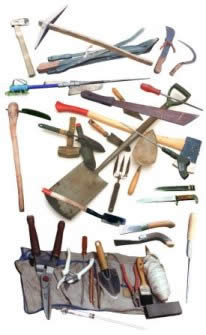
The
picture above shows typical demining tools - ranging from pickaxes
and shovels to machetes, screwdrivers and garden trowels.

This
is a typical toolkit for Afghan deminers. Not every deminer
has every part.
There is an AK bayonet which is the
most popular prodder and also a simple locally made probe with
a side handle - the side handle allows both hands to be used
to push. This has the advantage of keeping the left hand further
away than when it simply guides the probe shaft.
And at the back is the ubiquitous hoe and pick-axe.

These
are other Afghan prodding tools. At the top is a thin mild-steel needle
prod with a wooden handle. It is hard to see the side handle,
but it is there.
In between is a red marker flag. At
the bottom is a bayonet and its sheath. Deminers like to use
a bayonet because you can prod and scrape with the same tool.
The bayonet has been involved in many accidents when deminers
lost fingers or their whole hand. It is too short for safely, and the hard plastic handle shatters in a blast sending sharp fragments back at the deminer. Handle shards have been removed from a deminer's chest after an accident.
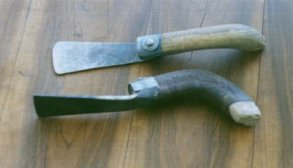
This
locally made Afghan tool is used as a demining scraper - It
was designed to be used in the building trade and is entirely inappropriate for use in exposing a mine safely.


A
demining toolset in Cambodia is shown above. There is a long thin probe
and a long-handled trowel Both have wooden handles that are separate from the mild-steel head. The disc is a speaker magnet used to find metal frgaments during excavation.
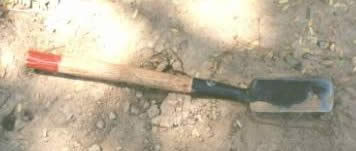
The
long handled trowels vary from purchase to purchase with little
consistency in manufacture. They have broken up and caused injury in accidents.

This
shows tools used by another demining NGO in Cambodia. The tools
include locally made items. The prod is actually manufactured
as a wood chisel. The tip has broken away and punctured body
armour in at least one accident.
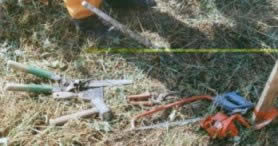
This
is a demining toolset used in Bosnia. It includes a lump hammer, a decorator's scraper
and a long probe. The decorator's
scraper and the probe are the only excavation tools - and are unfit for the purpose because they are too short and will break up in a blast.
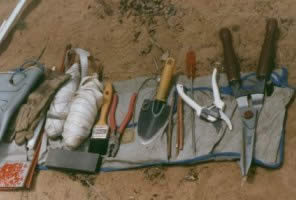
An
INGO's toolset is shown above. The long
screwdriver is their prodder. The handle is hard plastic.
The trowel is a gardener's trowel with a separate hard plastic
handle.
The paint-brush is used to remove 'sticky' earth
from the side of something that has been uncovered. It is much too soft to do the job well.
The wooden sticks
are laid in a cross on the ground to mark the centre of a detector
signal.
The secateurs are used to cut roots and tough
vegetation. Trowels like this almost invariably break up in
accidents and the parts have caused severe injury.
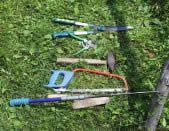
This
is a demining group's toolset in Bosnia and Croatia. The prodder
breaks down and the blade fits inside the handle for transport.
The trowel is a builder's cementing trowel. The shears and secateurs
are the usual gardener's tools. Tools that separate for easy transport will also separate in a blast and parts may hit the deminer.
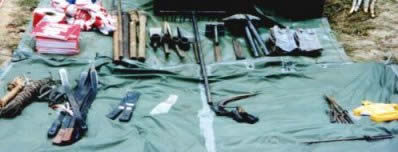
A
commercial group's tools for an entire demining team in Africa
is shown above. The use of machetes, rakes, shovels and pickaxes
may seem a little extreme, but many groups do so. The sickle is also
common as a grass cutter. The panga is a machete with a bent
end used for cutting grass while standing.
This group's
prodder is a bent piece of 12mm mild-steel reinforcing bar.
It is the only tool that is made for the purpose. They had several accidents with the prodder and got
a large number of purpose designed tools (AVS
design) afterwards.
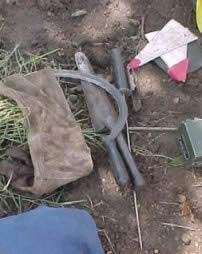
Another
commercial company's tools in Africa are shown above. The long
prodder is one of my early designs. The three tools, long glove
and markers are all the tools that a deminer was issued by this
group. The long trowel is locally made using mild steel. Those
in use for a long time had worn down to half the length. Poorly made and badly designed, those
involved in accidents have broken up and caused severe injury.
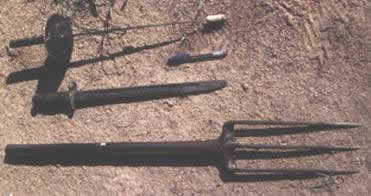
The
picture above shows another INGO's tools many years ago. The
bayonet blade is 18" (45cm) long. The trident was used as a
fast probe. Both the trident and the rapier with a steel handguard
were locally made, and commendably long. Unfortunately this
group's tools changed over the years.
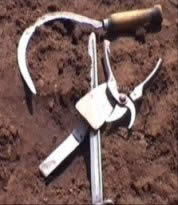
The
same group's tools later. A sickle, secateurs,
a scraper and the long bayonet. The long-handled trident and rapier
were no longer standard equipment.
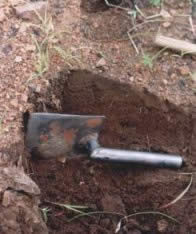
This
is what their scraper looks like when new. It is locally made
using mild steel and is far too short to keep the deminer's hand safe in a blast, especially because they allow the demner to have both hands on the tool.
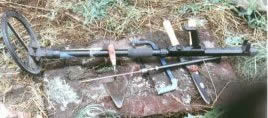
A
demining group does not use the same tools in every country.
These are the same INGO's tools in Bosnia.
The probe
blade turns around and screws inside the handle for transport.
Notice the cheap and dangerous builder's trowel employed as a scraper again.
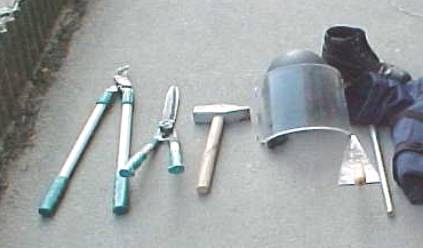
The
picture above shows a commercial company's tools in Kosovo.
Note the builder's trowel, lump hammer and long probe (under
the boot).

These
are the tools used by the national demining group in Mozambique.
Note the long probe buried among the tools.
Also a long trowel (AVS design).
Both of these have rubber hand-guards made using off-cuts of
conveyor belt - which is fibre-reinforced rubber. This is a safe variation of my design, which is exactly what I wanted to happen.

Here are the tools used by an INGO in Iraq. Note the wire-cutters, needed because many of the mined areas are marked with barbed-wire. Other tools are locally made because importing was not possible at the time. Their quality is varied and their handles often loose. The construction and the length are both inadequate.
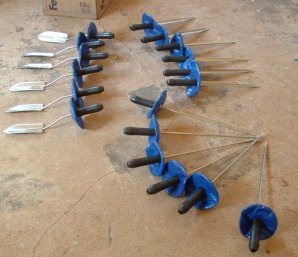
The picture above shows a six man team's blast-resistant excvation/signal-investigation tools. The handguards are made using flexible aramid material and the tools stay together in AP mine blasts. These are my designs and I am frequently finding them in unexpected places when I travel, which is rather nice.
That
is an introduction to the tools that are used around the world.
They vary all the time - with many groups buying whatever they
can get cheaply - and the tools they buy are frequently inadequate
because they were not designed for the purpose.
See
also, the Need
for better hand-tools, Hand-tool design critera and Developing safer demining hand-tools.
Return to Introducing demining.
HOME
|
|